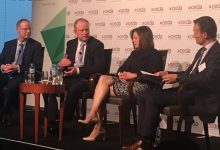Australia’s remaining coal-fired power plants are on borrowed time, and are as likely to be retired sooner rather than later, the chief of Australia’s Energy Market Operator has confirmed, in a keynote speech outlining the core assumptions used to shape AEMO’s Integrated System Plan.
Speaking at a CEDA event in Melbourne on Wednesday, AEMO’s Audrey Zibelman offered some fascinating insights into the complex modelling behind the ISP, which – published in June last year – is so far, by far the best plan the industry has come up with to guide Australia’s National Electricity Market transition.
Zibelman said one of the key aims of AEMO was to redress the “information asymmetry” that had previously thwarted progressive change on the NEM, by having “a very open and transparent process.”
As she put it, there are certain things AEMO would say “absolutely need to get done under any circumstances – in other words, with least regrets.”
And at the top of that list is replace the outgoing Liddell coal plant, in New South Wales, and accommodating the new renewable energy capacity that is already coming in to replace it, by bolstering transmission networks and backing it up with storage.
“We call those our group one. Those are the projects that we are really going to need to get done. For example, we know that – AGL has told us – that Liddell is going to retire, AEMO has looked at that, so we absolutely need to get new resources into NSW.
“That has to be done, not just in time… but in advance, so that we can get it done and make sure that when that plant retires, we have the capability to meet those needs and that helps us integrate, also, additional renewables.
“You can kind of wish things weren’t so, but frankly, they’re so,” Zibelman added.
“So in the case of the power system, as the plants retire – I mean we’re largely talking about coal that are going to be retiring at the end of their useful life – they have to be replaced.
“So there’s going to be an investment cost… depending on what’s going on, anywhere between $8-27 billion, which sounds like a lot, but it really depends on the choices that get made.”
And that is what the ISP is about, she said – a plan to guide the best-fit and least-cost way forward, using all the information and resources at hand.
The second phase of the ISP, Zibelman explained, is what AEMO calls the group 2 projects – and that, too, is focused on the potentially rapid retirement of coal.
“On that we’re doing some additional work, because for us, those projects sort of fall into …the bucket of what we’re going to need to have happen in advance of the next stage of coal plant retirements.
“One of our concerns there, and what we’ll be working with the ESB on, is that we looked at this from the standpoint of the coal retiring at what we would say is technically logical time, but there’s always a risk that something will happen and that they’ll retire earlier and we’ll need to have projects in place.
“Again, you don’t want to wait until the last minute and be in a crisis mode, you want to be able to plan for it,” she said.
“So we’ll be working with folks to say, well what happens if the coal retires earlier, what should we have in place to make sure the system is reliable, and the ESB is working with us on that.”
“By putting a plan like that together, we’re going to able to be the most efficient in terms of a cost basis,” Zibelman added.
And as Hydro Tasmania’s Stephen Davy noted, there could be a number of reasons why Australia’s existing coal plant might retire early, but economics are by far the biggest factor, and they’re changing very quickly.
“The first version of the ISP identified that Australia is going to need 17GW of storage in the system by 2040, and that’s assuming that a lot of the coal-fired plant will keep going until either at the end of its identified design life or 50 years, whichever is more appropriate,” Davy told the CEDA luncheon.
“And what that means is, if the coal-fired plant closes earlier, which it may well do – not necessarily because (it) has failed to work properly, but more because the economics behind sustaining their life are vastly eroded, because the uptake of new renewables has been quicker –that target …could come upon us very, very quickly.”
Davy also noted that he felt Australia was in good hands to meet the huge challenges ahead.
“We’re very fortunate in Australia that we’ve got someone of Audrey’s calibre and energy,” he said. “It’s a very serious role, we’re in middle of a very big transition.”










